Using Parallel Magics¶
IPython has a few magics for working with your engines.
This assumes you have started an IPython cluster, either with the notebook interface, or the ipcluster/controller/engine commands.
[1]:
import ipyparallel as ipp
cluster = ipp.Cluster()
cluster.start_cluster_sync(n=4)
rc = cluster.connect_client_sync()
rc.wait_for_engines(4)
dv = rc[:]
rc.ids
Using existing profile dir: '/home/docs/.ipython/profile_default'
Starting 4 engines with <class 'ipyparallel.cluster.launcher.LocalEngineSetLauncher'>
100%|██████████| 4/4 [00:08<00:00, 2.07s/engine]
[1]:
[0, 1, 2, 3]
%px, %%px, %pxresult, pxconfig, and %autopx.Now we can execute code remotely with %px:
[2]:
%px a=5
[3]:
%px print(a)
[stdout:2] 5
[stdout:1] 5
[stdout:3] 5
[stdout:0] 5
[4]:
%px a
Out[0:3]: 5
Out[1:3]: 5
Out[2:3]: 5
Out[3:3]: 5
[5]:
with dv.sync_imports():
import sys
importing sys on engine(s)
[6]:
%px from __future__ import print_function
%px print("ERROR", file=sys.stderr)
[stderr:1] ERROR
[stderr:0] ERROR
[stderr:3] ERROR
[stderr:2] ERROR
You don’t have to wait for results. The %pxconfig magic lets you change the default blocking/targets for the %px magics:
[7]:
%pxconfig --noblock
[8]:
%px import time
%px time.sleep(1)
%px time.time()
[8]:
<AsyncResult: execute>
But you will notice that this didn’t output the result of the last command. For this, we have %pxresult, which displays the output of the latest request:
[9]:
%pxresult
Out[0:8]: 1631278502.24939
Out[1:8]: 1631278502.2469072
Out[2:8]: 1631278502.2612648
Out[3:8]: 1631278502.2637527
Remember, an IPython engine is IPython, so you can do magics remotely as well!
[10]:
%pxconfig --block
%px %matplotlib inline
[stderr:1] WARNING:matplotlib.font_manager:Matplotlib is building the font cache; this may take a moment.
[stderr:2] WARNING:matplotlib.font_manager:Matplotlib is building the font cache; this may take a moment.
[stderr:3] WARNING:matplotlib.font_manager:Matplotlib is building the font cache; this may take a moment.
[stderr:0] WARNING:matplotlib.font_manager:Matplotlib is building the font cache; this may take a moment.
%%px can be used to lower the priority of the engines to improve system performance under heavy CPU load.
[11]:
%%px
import psutil
psutil.Process().nice(20 if psutil.POSIX else psutil.IDLE_PRIORITY_CLASS)
[12]:
%%px
import numpy as np
import matplotlib.pyplot as plt
%%px can also be used as a cell magic, for submitting whole blocks. This one acceps --block and --noblock flags to specify the blocking behavior, though the default is unchanged.
[13]:
dv.scatter('id', dv.targets, flatten=True)
dv['stride'] = len(dv)
[14]:
%%px --noblock
x = np.linspace(0,np.pi,1000)
for n in range(id,12, stride):
print(n)
plt.plot(x,np.sin(n*x))
plt.title("Plot %i" % id)
[14]:
<AsyncResult: execute>
[15]:
%pxresult
[stdout:0]
0
4
8
[stdout:1]
1
5
9
[stdout:2]
2
6
10
[stdout:3]
3
7
11
[output:0]

[output:1]
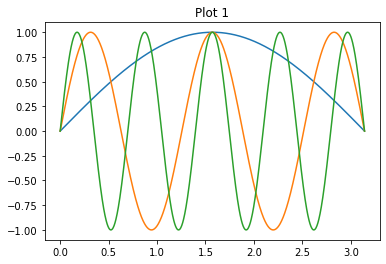
[output:2]
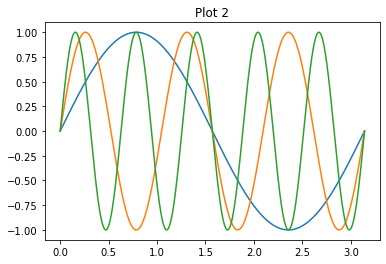
[output:3]
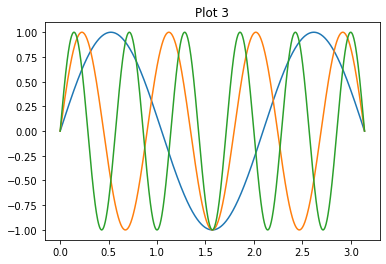
Out[0:12]: Text(0.5, 1.0, 'Plot 0')
Out[1:12]: Text(0.5, 1.0, 'Plot 1')
Out[2:12]: Text(0.5, 1.0, 'Plot 2')
Out[3:12]: Text(0.5, 1.0, 'Plot 3')
It also lets you choose some amount of the grouping of the outputs with --group-outputs:
The choices are:
engine- all of an engine’s output is collected togethertype- where stdout of each engine is grouped, etc. (the default)order- same astype, but individual displaypub outputs are interleaved. That is, it will output the first plot from each engine, then the second from each, etc.
[16]:
%%px --group-outputs=engine
x = np.linspace(0,np.pi,1000)
for n in range(id+1,12, stride):
print(n)
plt.figure()
plt.plot(x,np.sin(n*x))
plt.title("Plot %i" % n)
[stdout:0]
1
5
9
[stdout:3]
4
8
[stdout:1]
2
6
10
[stdout:2]
3
7
11
[output:3]

[output:3]
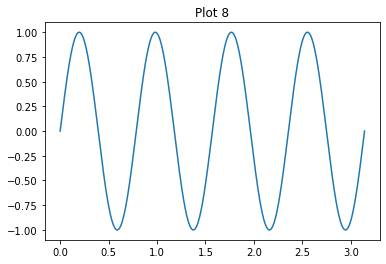
[output:0]
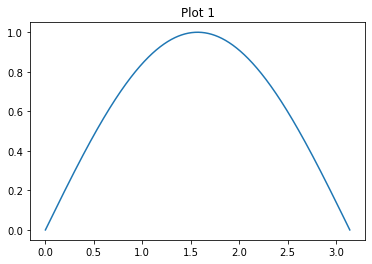
[output:2]
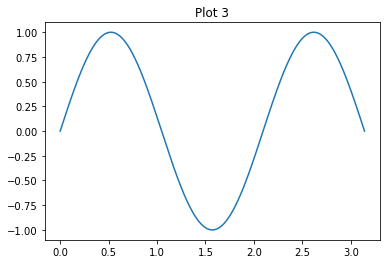
[output:1]
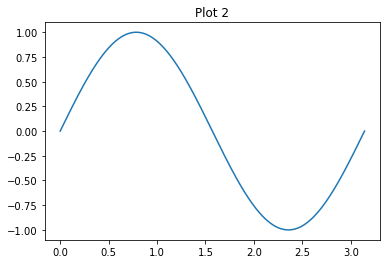
[output:0]
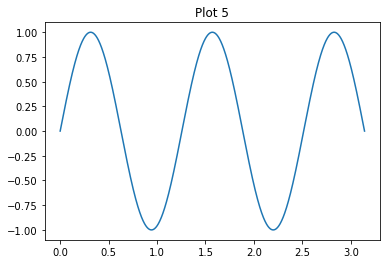
[output:1]
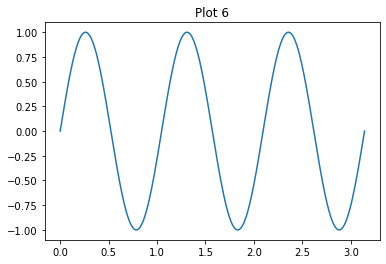
[output:2]
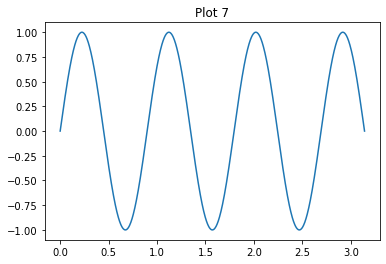
[output:0]
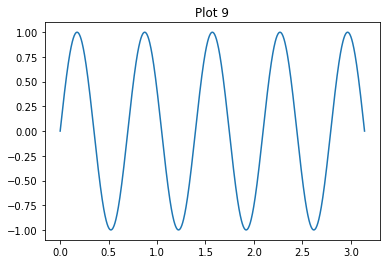
[output:1]
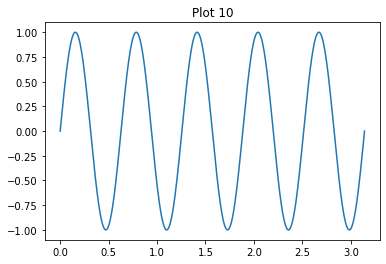
[output:2]
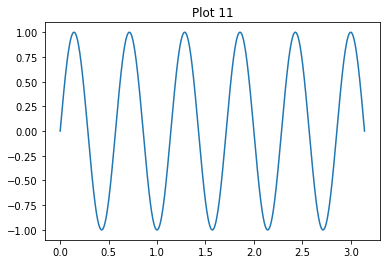
When you specify ‘order’, then individual display outputs (e.g. plots) will be interleaved.
%pxresult takes the same output-ordering arguments as %%px, so you can view the previous result in a variety of different ways with a few sequential calls to %pxresult:
[17]:
%pxresult --group-outputs=order
[stdout:0]
1
5
9
[stdout:1]
2
6
10
[stdout:2]
3
7
11
[stdout:3]
4
8
[output:0]
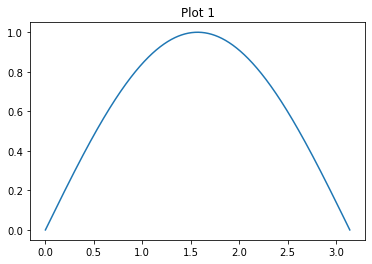
[output:1]
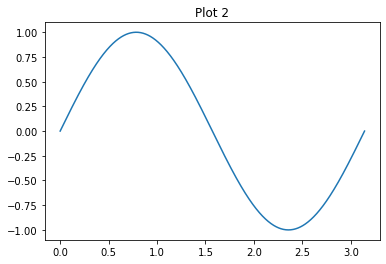
[output:2]
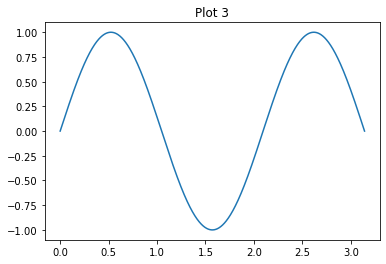
[output:0]
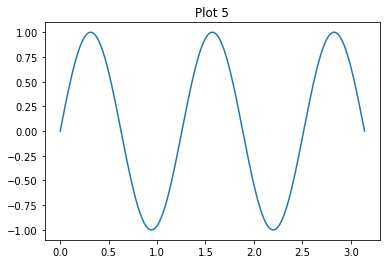
[output:1]

[output:2]
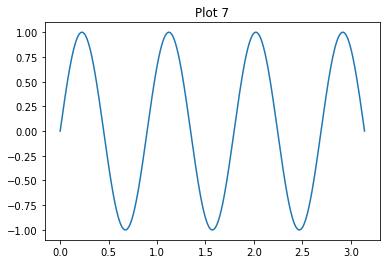
[output:0]

[output:1]
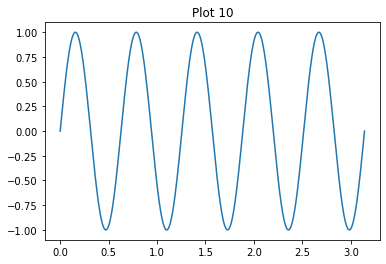
[output:2]
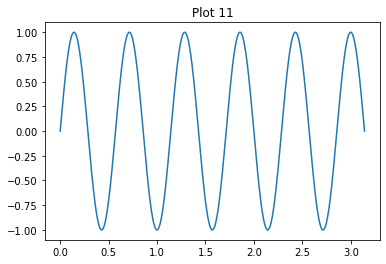
Single-engine views¶
When a DirectView has a single target, the output is a bit simpler (no prefixes on stdout/err, etc.):
[18]:
from __future__ import print_function
def generate_output():
"""function for testing output
publishes two outputs of each type, and returns something
"""
import sys,os
from IPython.display import display, HTML, Math
print("stdout")
print("stderr", file=sys.stderr)
display(HTML("<b>HTML</b>"))
print("stdout2")
print("stderr2", file=sys.stderr)
display(Math(r"\alpha=\beta"))
return os.getpid()
dv['generate_output'] = generate_output
You can also have more than one set of parallel magics registered at a time.
The View.activate() method takes a suffix argument, which is added to 'px'.
[19]:
e0 = rc[-1]
e0.block = True
e0.activate('0')
[20]:
%px0 generate_output()
[stdout:3] stdout
[stderr:3] stderr
[output:3]
[stdout:3] stdout2
[stderr:3] stderr2
[output:3]
Out[3:14]: 2558
[21]:
%px generate_output()
[stdout:2] stdout
[stderr:2] stderr
[output:2]
[stdout:2] stdout2
[stdout:1] stdout
[stderr:1] stderr
[stderr:2] stderr2
[output:2]
[output:1]
[stdout:1] stdout2
[stderr:1] stderr2
[output:1]
[stdout:0] stdout
[stdout:3] stdout
[stderr:3] stderr
[output:3]
[stdout:3] stdout2
[stderr:0] stderr
[output:0]
[stdout:0] stdout2
[stderr:3] stderr2
[stderr:0] stderr2
[output:3]
[output:0]
Out[0:14]: 2551
Out[1:14]: 2553
Out[2:14]: 2555
Out[3:15]: 2558
As mentioned above, we can redisplay those same results with various grouping:
[22]:
%pxresult --group-outputs order
[stdout:0]
stdout
stdout2
[stdout:1]
stdout
stdout2
[stdout:2]
stdout
stdout2
[stdout:3]
stdout
stdout2
[stderr:0]
stderr
stderr2
[stderr:1]
stderr
stderr2
[stderr:2]
stderr
stderr2
[stderr:3]
stderr
stderr2
[output:0]
[output:1]
[output:2]
[output:3]
[output:0]
[output:1]
[output:2]
[output:3]
Out[0:14]: 2551
Out[1:14]: 2553
Out[2:14]: 2555
Out[3:15]: 2558
[23]:
%pxresult --group-outputs engine
[stdout:0]
stdout
stdout2
[stderr:0]
stderr
stderr2
[output:0]
Out[0:14]: 2551
[stdout:1]
stdout
stdout2
[stderr:1]
stderr
stderr2
[output:1]
Out[1:14]: 2553
[stdout:2]
stdout
stdout2
[stderr:2]
stderr
stderr2
[output:2]
Out[2:14]: 2555
[stdout:3]
stdout
stdout2
[stderr:3]
stderr
stderr2
[output:3]
Out[3:15]: 2558
Parallel Exceptions¶
When you raise exceptions with the parallel exception, the CompositeError raised locally will display your remote traceback.
[24]:
%%px
from numpy.random import random
A = random((100, 100, 'invalid shape'))
[0:execute]:
---------------------------------------------------------------------------
TypeError Traceback (most recent call last)
/tmp/ipykernel_2551/1064401740.py in <module>
1 from numpy.random import random
----> 2 A = random((100, 100, 'invalid shape'))
mtrand.pyx in numpy.random.mtrand.RandomState.random()
mtrand.pyx in numpy.random.mtrand.RandomState.random_sample()
_common.pyx in numpy.random._common.double_fill()
TypeError: 'str' object cannot be interpreted as an integer
[1:execute]:
---------------------------------------------------------------------------
TypeError Traceback (most recent call last)
/tmp/ipykernel_2553/1064401740.py in <module>
1 from numpy.random import random
----> 2 A = random((100, 100, 'invalid shape'))
mtrand.pyx in numpy.random.mtrand.RandomState.random()
mtrand.pyx in numpy.random.mtrand.RandomState.random_sample()
_common.pyx in numpy.random._common.double_fill()
TypeError: 'str' object cannot be interpreted as an integer
[2:execute]:
---------------------------------------------------------------------------
TypeError Traceback (most recent call last)
/tmp/ipykernel_2555/1064401740.py in <module>
1 from numpy.random import random
----> 2 A = random((100, 100, 'invalid shape'))
mtrand.pyx in numpy.random.mtrand.RandomState.random()
mtrand.pyx in numpy.random.mtrand.RandomState.random_sample()
_common.pyx in numpy.random._common.double_fill()
TypeError: 'str' object cannot be interpreted as an integer
[3:execute]:
---------------------------------------------------------------------------
TypeError Traceback (most recent call last)
/tmp/ipykernel_2558/1064401740.py in <module>
1 from numpy.random import random
----> 2 A = random((100, 100, 'invalid shape'))
mtrand.pyx in numpy.random.mtrand.RandomState.random()
mtrand.pyx in numpy.random.mtrand.RandomState.random_sample()
_common.pyx in numpy.random._common.double_fill()
TypeError: 'str' object cannot be interpreted as an integer
Remote Cell Magics¶
Remember, Engines are IPython too, so the cell that is run remotely by %%px can in turn use a cell magic.
[25]:
%%px
%%timeit
from numpy.random import random
from numpy.linalg import norm
A = random((100, 100))
norm(A, 2)
[stdout:1] 5.85 ms ± 108 µs per loop (mean ± std. dev. of 7 runs, 100 loops each)
[stdout:2] 6.01 ms ± 108 µs per loop (mean ± std. dev. of 7 runs, 100 loops each)
[stdout:0] 6.29 ms ± 714 µs per loop (mean ± std. dev. of 7 runs, 100 loops each)
[stdout:3] 6.39 ms ± 503 µs per loop (mean ± std. dev. of 7 runs, 100 loops each)
Local Execution¶
You can instruct %%px to also execute the cell locally. This is useful for interactive definitions, or if you want to load a data source everywhere, not just on the engines.
[26]:
%%px --local
import os
thispid = os.getpid()
print(thispid)
2497
[stdout:0] 2551
[stdout:1] 2553
[stdout:2] 2555
[stdout:3] 2558